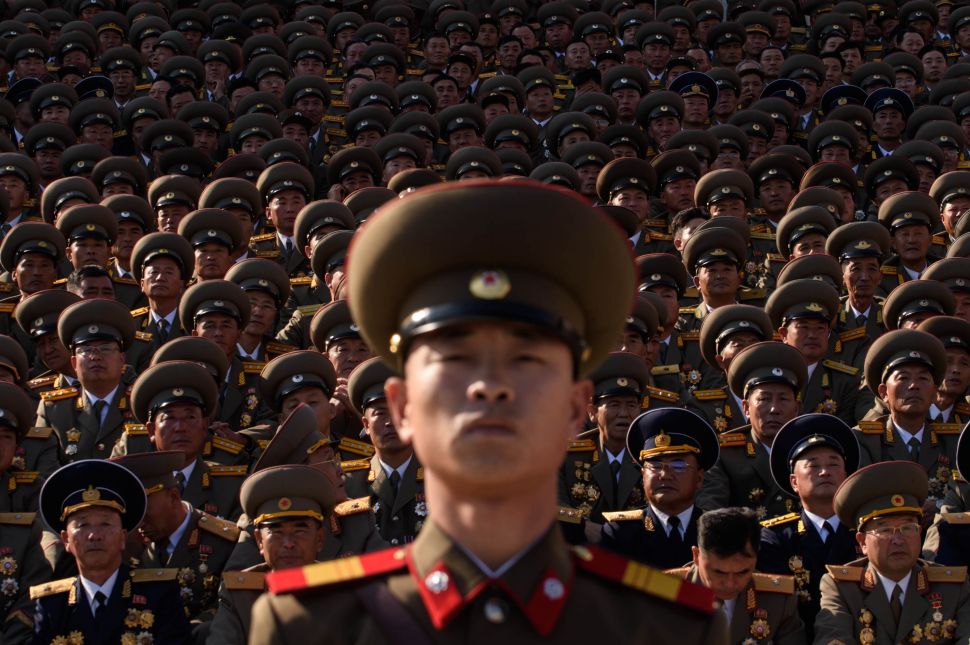
It’s that time of year again!
Ever since Gerald Ford’s administration, the United States’ and South Korean armed forces have engaged in military exercises to practice what a conflict with North Korea (the DPRK) would look like. The first such dress rehearsal took place in 1976, shortly after North Korean soldiers axed two Americans to death when they attempted to chop down a tree in the demilitarized zone (DMZ) that divides the two Koreas. Three days later, the American forces launched the quaintly-titled Operation Paul Bunyan, rallying an overwhelming show of strength and cutting the tree down to a stump.
According to the North Korean mythology, the so-called “U.S. imperialists” are desperate to make Korea their Asian beachhead as part of an attempt at world domination. So suffused is anti-Americanism in their vernacular that articles and textbooks blithely refer to “Yank bastards.” The U.S. imperialists have supposedly been plotting to seize Korea at least since the 1860s when U.S.S. General Sherman visited the country. The natives of current North Korean capital Pyongyang sank the vessel to the bottom of the Taedong River and killed the crew as well. The North Koreans claim that the assailants were direct ancestors of the Great Leader Kim Il Sung and the Dear Leader Kim Jong Il—without any basis in fact.
North Korean fears about American conquest do have basis in truth. The DPRK insists that Korea is one nation, indivisible since the Paleolithic era. As a result, the names of the two countries are rendered there as north and south Korea—the south being a region under U. S. imperialist occupation. The only thing keeping us Yank devils from conquering the north is whoever the current leader happens to be—in this case Marshal Kim Jong Un. One of the reasons activists tried to smuggle the film The Interview into North Korea is that it demonstrated that Americans do not, in fact, tremble in our boots at the mention of the leader’s name.
Though in the United States the Korean War is regarded as “the Forgotten War,” in the DPRK it’s precisely the opposite. Their entire history is grounded in the Great Leader Kim Il Sung driving the “Jap devils” out of Korea during the “Pacific War” (i.e., World War II) and then later winning the “Fatherland Liberation War” and expelling the hook-nosed Americans out of the northern half of the republic after we supposedly launched a dastardly sneak attack in 1950. This is so integral to North Korean history that when refugees learn that it was in fact Kim Il Sung who started the Korean War, it’s been described as akin to an American discovering that FDR bombed the Japanese at Pearl Harbor.
With the United States and the United Nations forces on one side and Russia and China on the other, it was Korea that paid the strongest proportional price for the Korean War. The country was leveled due to bombing and a see-saw conflict that had both sides retreating at different times—leaving death and devastation. That this could happen again at any moment is not far-fetched for the North Korean population to believe, as the 1950s were within memory for many still in the north, and their culture remains continuous since then in many ways. As such, it’s no wonder that these annual American military exercises are used to prove that we are about to invade again and finish what we started. It’s controversial but hard to dispute that the American armed forces have a well-established history of overthrowing governments when it suits our interests, both violently and overtly as in Iraq and quietly and subversively in other instances.
On the other hand, when basic communication is purposely rendered obtuse, force is the only remaining option. The North Korean government is the most oppressive on earth, and regime change would be more defensible there than anywhere else. Any talk of human rights is blithely dismissed by the DPRK government. They claim that their version of human rights means national sovereignty, so trying to undermine their government is a violation of their “human rights.”
At this very moment, there are a few hundred thousand people in concentration camps in the DPRK. Officially, the North Koreans baldly state that since they do not use the term “concentration camps” they do not have any there. Regardless of the semantics, the camp inhabitants are told consistently and explicitly that, should the U. S. imperialists invade North Korea, the camps would be razed and all its occupants killed. An assault on North Korea would therefore guarantee immediate genocide.
There are no easy answers—or even difficult but feasible ones—to the DPRK problem. This’s why, year after year, American forces go through the same motions with our military and Western journalists report the same livid North Korean response. The timewarp that pervades the DPRK extends beyond the borders of the Hermit Kingdom. The kindling for a new government is there, but what the spark sets it off looks like is virtually impossible to predict.
Michael Malice is the author of Dear Reader: The Unauthorized Autobiography of Kim Jong Il. Follow him on Twitter @michaelmalice.

